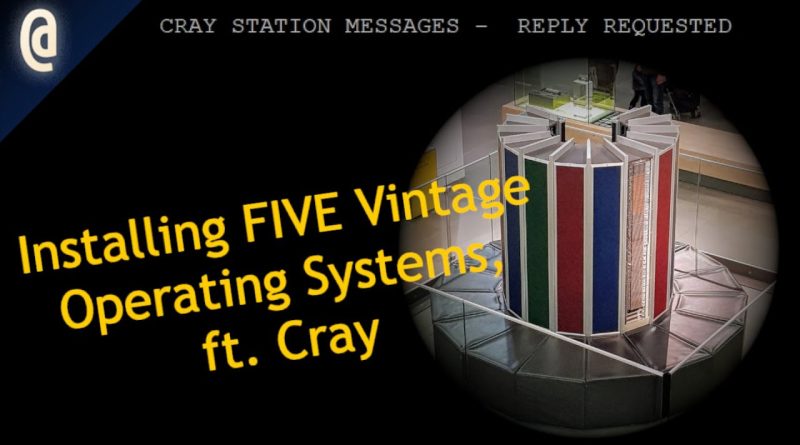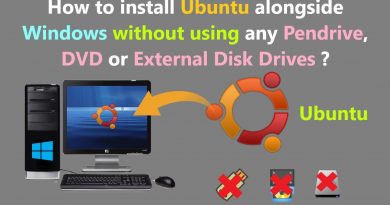Installing Five Rarely Used Vintage Operating Systems Rapidfire (ft. Cray mainframes)
Support the Channel
Ko-Fi: https://ko-fi.com/ncommander
Patreon: https://www.patreon.com/ncommander
Come Hang Out:
Discord: https://discord.gg/V8esNah
Mastodon: https://social.restless.systems/@ncommander
Wiki: https://restless.systems
COS Recovery Story:
* https://www.modularcircuits.com/blog/articles/the-cray-files/
* https://chrisfenton.com/
—
An operating system is an essential piece of software that every computer uses to control its base functions. Most of us are familiar with Windows, macOS, and/or Linux, but there are some so obscure that most watching will see them first hand. For example, did you know Microsoft released a copy of Windows for Legacy PCs? Or that Apple simply slapped the Platinum look and feel on NeXTstep, and callled it Mac OS X Server 1.0?
In this video, we’re going to install five operating systems that are so obscure, you’ve probably never heard of them before. They are, in order:
* Dell UNIX – https://gunkies.org/wiki/Dell_UNIX)
* Windows for Legacy PCs – https://en.wikipedia.org/wiki/Windows_Fundamentals_for_Legacy_PCs
* Mac OS X Server 1.0 – https://en.wikipedia.org/wiki/Mac_OS_X_Server_1.0
* Sprite – https://en.wikipedia.org/wiki/Sprite_(operating_system)
* Windows 11 for ARM
* COS
Music used in order from YouTube Creator Library:
* Jeremy Blake – Heaven and Hell
* Huma-Huma – From Russia With Love
* Patrick Patrikios – The Awakening
* DivKid – Icelandic Arpeggios
* Kevin MacLeod – Five Armies
* Jimena Contreras – Hopeless
* Huma-Huma – Hydra
by NCommander
linux foundation




I am really (unpleasantly) surprised that a machine as iconic and important as the Cray has been lost in time. At least some brave soul managed to recover parts of it.
This has initiated a flood of old horrors in my brain that I had thought were long banished.
"Tactical use of dd" – best quote ever
What no SCO Xenix? 🤣👍
the simple fact that COS is terribly unfriendly to the user, and not existing in any modern capacity is quite poetic
scrolled thru the comments – not found anything:
somewhat went very wrong with that voice-over
He wasn't inactive for a year, he was just trying to edit this video in these OSes. 😁😁😁
4:11 Future livestream idea: Try porting OAM (sysadm) from System V to Linux. It is a part of the UNIX SVR4 source code.
It is almost like Cray borrowed a lot from CDC's NOS. I remember some of that.
That would be a fun project. Bringing back the Cyber Network Operating Systems (NOS and NOS/VE). That was a cool OS and machine series.
SUPER-UX and its cousin ESOS are likely to be lost to history. SUPER-UX was a UNIX variant used on NEC's SX line of vector supercomputers up until Linux was adopted. ESOS was the operating system for the Earth Simulator and the Earth Simulator 2.
Many older Cray systems- and this included the CDC 6600 and 7600- ran the operating system in the I/O processors to allow the main processor to be free to work on computing tasks. This was also true of many CDC CYBER systems.
Dell UNIX was sold with their PowerLine Workstations like the elusive 433DE+, which oddly took a CPU which plugged into a mezzanine card on one side of the mainboard, and had a 4-character green alphanumeric LED display for system status.
UNIX PCs of this era would include DOS so that they could market a PC that could run DOS apps but also natively talk to their UNIX networks. So DOS would run on top and UNIX would handle the interoperability. AT&T also did this with their UNX PC line.
I have to admit I have never heard DOS pronounced like that before, interesting.
Great video but please cut down on the AI postprocessing or gate or whatever is causing half of your speech being cut off.. listening with headphones it is really difficult to enjoy.
There are way easier ways to install windows 11 arm64 on UTM than what you did. We used UUPDump to generate an ISO and it installed sucessfully without any hacks or bells and whistles inside UTM on a Silicon M2 mac. Guest additions also work fine. The only problem was that we had to create the ISO on an existing windows x64 machine
The hyper floppy install reminds me of installing OS2 in 1993. I believe it was 103 disks all up, which at $149 retail was cheaper than buying that many floppies, and those IBM ones were good ones..
The Cray segment reminds me of the MVS Turnkey System emulator that emulates an IBM System/370 machine. I’ve only messed around a little bit, but the sheer difference in how you interact with the mainframe system vs modern computers is wild
Never run into Sprite, sounds interesting. Give Plan 9 a try sometime, it sounds like a similar implementation.
Recall installing various versions of AT&T Unix that used a similar number of disks. Oracle RDBMS was another enthusiastic diskette user. Building BSD Unix on a PDP was also lots and lots of fun, configuring and messing with the various setups of hardware that were available. BSD on Vaxen was relatively simple.
VMWare Fusion offers "Out of the Box" Win11 ARM install. But you'll need to purchase a license key. Have been running Win11 ARM without any problem on my Mac Studio for months now.
I have a few CDC disk packs which may contain cray software and am currently restoring a suitable drive. Unfortunately the disk pack likely to have a OS is crashed and isn't recoverable
I remember buying Tenons Mach OS, I never installed it, back when Mac was very fragile and I didn't trust Linux, maybe $2k down the toilet and 20 floppies and books in landfill.
Not many i would assume… The people who used unix at the time would be fine with 0 based indexing… Wow original X lul…
Would be great to have a table of contents if you could!
Its amazing how many pieces of software were out there. Being able to see all of this from the screen of a cell phone is amazing in many ways by itself.
Great job!!
Was looking for the 1 foot (1 ft.) Cray. 💡
very impressive sir!
X11 needs the x86config file (at least in the early Linux kernel and Slackware distro days. You need to figure out all of the dot pitch, and H and V timing parameters to be entered.
I did it a bunch of times back in the mid-90s, but have forgotten how most of it works now… Might need to pull all the old readmes! but you probably knew that already… 🙂
you may need to use the mknod command to generate and write the correct magic numbers to the dev mount point. But you probably knew that already… 🙂